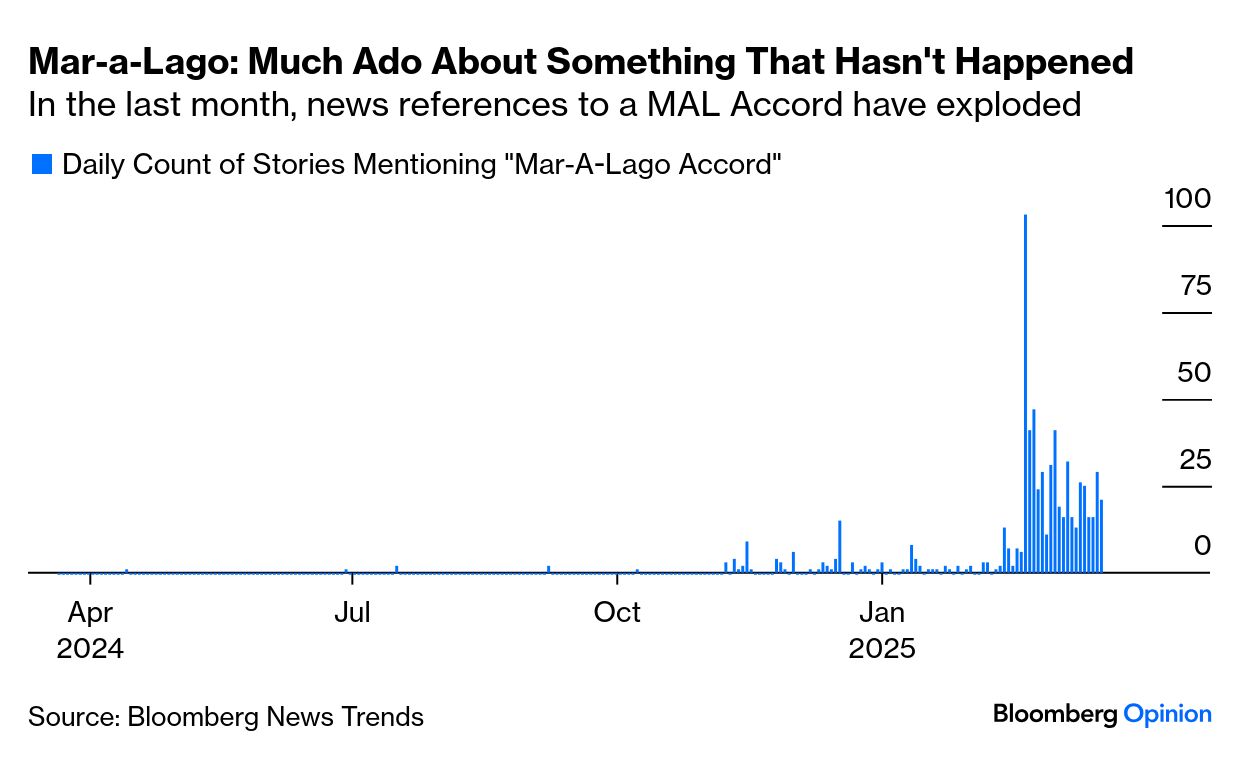Uddrag fra Authers:
Margin-a-Lago Accord |
It can be difficult to remember that the Mar-a-Lago Accord hasn’t happened yet. Leaders haven’t been convened to Palm Beach, and there’s no agenda for what such an accord could include. But that hasn’t stopped people talking or journalists writing about it. This shows the total number of stories (from all sources) mentioning a “Mar-a-Lago Accord” each day on the Bloomberg terminal for the last year:

But what is it, and can it really happen? There are huge variations, but the common themes seem to be that an accord would be an international agreement designed to:
- Weaken the dollar, and
- Prompt far more foreign direct investment into the US.
The overarching aim is to bring back manufacturing jobs at a price that the US can afford or, alternatively, to roll back globalization so that the US can escape its greatest downsides (inequality and the hollowing out of the working class) without sacrificing its upsides (low inflation, strong asset prices and low interest rates). Tariffs should be viewed primarily as a toll to get there, and also as a fallback option if an accord can’t be reached.
These are wholly reasonable aims, for which the administration has a mandate. It’s not clear that they’re achievable, or that other countries have any reason to go along with them. Adam Tooze of Columbia University describes the idea as “on its face a far-fetched policy proposal” in which it’s easy to pick holes. He suggests that the notion is only taken seriously because “we are all struggling to find some kind of rational purchase on the unhinged situation created by the Trump administration.” These are strong words, but the retreat of stocks in the last few weeks is in large part driven by investors coming around to his point of view.
So how does the US propose to make this happen? Various possibilities include:
- Threats of tariffs.
- A sovereign wealth fund to manipulate the currency and replace flows of capital from abroad.
- Coercion on defense; those who agree can benefit from the US security umbrella while those who don’t cannot, or as Stephen Miran, chair of the Council of Economic Advisers, put it: “Countries that want to be inside the defense umbrella must also be inside the fair trade umbrella.”
- Big cuts to the federal budget to reduce the deficit.
- Putting pressure on the Federal Reserve (under new leadership next year) to cut rates. (The president opined on Truth Social that “The Fed would be MUCH better off CUTTING RATES as US Tariffs start to transition (ease!) their way into the economy.”)
- And possibly Tobin transaction taxes, to create a cost for holding US dollars as reserves.
We’ve seen action on the first four already, although with minimal detail on all of them. The fifth, as foreshadowed by the presidential overnight communication, would be most unwelcome on markets. Beyond that, implementation of any of this promises to be a huge challenge.
That’s because, first, the US dollar isn’t as massively overvalued as it was at the time of the 1985 Plaza Accord (struck at a New York hotel that subsequently belonged to Trump for a while), which is the model for an international agreement to weaken the dollar. That makes it harder to bring down in a significant way. On a real trade-weighted basis, the currency is certainly very expensive, but not as extreme as 40 years ago, according to the Fed’s own index: Further, Plaza involved only the biggest countries in the then-developed
capitalist world. The globe has since gotten bigger, making it far harder to find a deal that everyone can live with. While Plaza worked for the US, it wasn’t so great for Japan, which entered a long-lasting slump a few years later. That won’t be lost on those who would stand to lose from a weaker dollar, such as China.
Tiffany Wilding, economist at Pimco, also points to the growth of foreign exchange markets since Plaza:
The sheer scale of the interventions required to create a meaningful dollar devaluation is staggering. Currency markets today see daily average turnover of some $7.5 trillion, according to the Bank for International Settlements. Even after adjusting for inflation, that’s about five times greater than the volume in 1989, in the years after the Plaza Accord.
Any agreement at Mar-a-Lago will not be able to weaken the dollar anything like as much as Plaza did by intervention alone.
Another problem is inflation. Globalization over time minimized it; and public tolerance for rising prices, we’ve learned in the last four years, is non-existent. Further, the concern is less inflation — slowing the rate at which prices are rising — as much as the price level. There’s a case that tariffs don’t create inflation, and the debate has already entangled the Fed’s Jerome Powell. It’s impossible to deny that they create a one-off rise in the price level. Using tariffs to create leverage, or as a source of revenue, is not the simple call it appears. It might hurt US counterparties more, but it will create much political pain at home.
Marko Papic of BCA Research points to a range of polls showing that voters care deeply about prices, while trade doesn’t matter to them. The political difficulty created by a spike in prices after Trump levied tariffs would be hard for the administration to navigate:

The greatest problem for any deal is getting others to agree. This is where the US may have already overplayed its hand. One widely circulating version of a MAL Accord had Europe agreeing to rearm by buying US weapons, in return for avoiding tariffs. But Trump 2.0 has shown itself so willing to withdraw from the Atlantic alliance that now even Germany’s once-staunchly Atlanticist new chancellor says the country needs “independence” from the US. European, not American, arms manufacturers are benefiting. The first act of Canada’s new prime minister has been to discuss defense with European leaders. Rather than accede to US demands, the international response so far has been to look for alternatives. This is understandable, as it grows ever more politically unpalatable for foreign leaders to rely on the US — and a range of countries now appear to be planning their own nuclear deterrents, which makes the security umbrella less important still.
Finally, Trump’s very unpredictability increases his leverage, but also tends to deter people from feeling confident in reaching an agreement with him. Former mentor and colleague Martin Wolf put it this way in the Financial Times:
He has, after all, abandoned Ukraine, put the commitment to NATO into doubt and mounted an assault on Canada. Is this administration capable of making a deal any sane person or country should trust? I think not.
The upshot is that while the US plainly would prefer some help weakening the dollar, the chances are that it will actually impose the tariffs. Trump refers to April 2, when his plan for reciprocal tariffs will be unveiled, as “Liberation Day.” Peter Tchir of Academy Securities argued that global tariffs will mean a “rocky road ahead for the economy”:
There is a lot of “chatter” about uncertainty. My fear is that the market isn’t pricing in what seems more and more certain — global tariffs shocking global supply chains.
Quite. Plenty of people on Wall Street are attracted to the various versions of the Mar-a-Lago Accord that have been circulated. Very few share the president’s enthusiasm for tariffs. It’s best to brace for them to happen.



